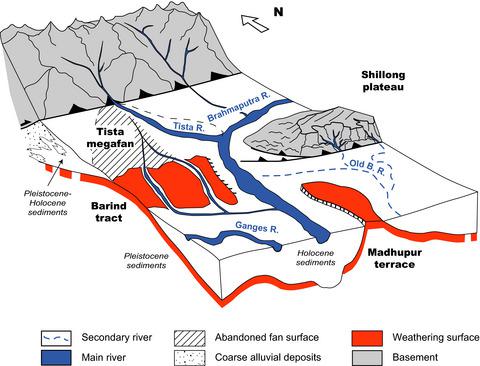当前位置:
X-MOL 学术
›
Basin Res.
›
论文详情
Our official English website, www.x-mol.net, welcomes your
feedback! (Note: you will need to create a separate account there.)
Flexural deformation controls on Late Quaternary sediment dispersal in the Garo‐Rajmahal Gap, NW Bengal Basin
Basin Research ( IF 2.8 ) Pub Date : 2019-12-29 , DOI: 10.1111/bre.12425 Jean‐Louis Grimaud 1, 2 , Celine Grall 3 , Steven Goodbred 4 , Michael S. Steckler 3 , Ryan Sincavage 4 , Jennifer L. Pickering 4 , Chris Paola 1, 2 , Leonardo Seeber 3 , Md. Saddam Hossain 5
Basin Research ( IF 2.8 ) Pub Date : 2019-12-29 , DOI: 10.1111/bre.12425 Jean‐Louis Grimaud 1, 2 , Celine Grall 3 , Steven Goodbred 4 , Michael S. Steckler 3 , Ryan Sincavage 4 , Jennifer L. Pickering 4 , Chris Paola 1, 2 , Leonardo Seeber 3 , Md. Saddam Hossain 5
Affiliation

|
[Sketch view of the study area showing the warping of Pleistocene sediments. Provenance analysis show a dispersal of sediment consistent with flexural deformation—in particular the abandonment of the Barind Tract by a Pleistocene Brahmaputra River and the current extents of the Tista megafan lobes. , Abstract Subsurface deformation is a driver for river path selection when deformation rates become comparable to the autogenic mobility rate of rivers. Here we combine geomorphology, soil and sediment facies analyses, and geophysical data of the Late Quaternary sediments of the central Garo‐Rajmahal Gap in Northwest Bengal to link subsurface deformation with surface processes. We show variable sedimentation characteristics, from slow rates (<0.8 mm/year) in the Tista megafan at the foot of the Himalaya to nondeposition at the exposed surface of the Barind Tract to the south, enabling the development of mature soils. Combined subsidence in the Tista fan and uplift of the Barind Tract are consistent with a N‐S flexural response of the Indian plate to loading of the Himalaya Mountains given a low value of elastic thickness (15–25 km). Provenance analysis based on bulk strontium concentration suggests a dispersal of sediment consistent with this flexural deformation—in particular the abandonment of the Barind Tract by a Pleistocene Brahmaputra River and the current extents of the Tista megafan lobes. Overall, these results highlight the control by deeply rooted deformation patterns on the routing of sediment by large rivers in foreland settings.]
中文翻译:

孟加拉盆地西北地区 Garo-Rajmahal Gap 晚第四纪沉积物扩散的弯曲变形控制
[研究区草图显示更新世沉积物的翘曲。物源分析表明沉积物的扩散与弯曲变形一致——特别是更新世布拉马普特拉河对 Barind Tract 的遗弃和 Tista megafan 裂片的当前范围。, 摘要 当变形率与河流的自生流动率相当时,地下变形是河流路径选择的驱动因素。在这里,我们结合了孟加拉西北部 Garo-Rajmahal Gap 中部晚第四纪沉积物的地貌、土壤和沉积相分析以及地球物理数据,将地下变形与地表过程联系起来。我们显示出不同的沉降特征,从慢速(<0. 8 毫米/年)在喜马拉雅山脚下的 Tista megafan 中到南部 Barind Tract 的裸露表面不沉积,从而使成熟土壤能够发育。Tista 扇中的联合沉降和 Barind Tract 的隆起与印度板块对喜马拉雅山脉加载的 N-S 弯曲响应一致,弹性厚度值较低(15-25 公里)。基于大量锶浓度的物源分析表明,沉积物的扩散与这种弯曲变形一致——特别是更新世布拉马普特拉河对巴林道的遗弃和 Tista 巨型扇叶的当前范围。总体而言,这些结果突出了根深蒂固的变形模式对前陆环境中大河流沉积物路线的控制。] 促进成熟土壤的发育。Tista 扇中的联合沉降和 Barind Tract 的隆起与印度板块对喜马拉雅山脉加载的 N-S 弯曲响应一致,弹性厚度值较低(15-25 公里)。基于大量锶浓度的物源分析表明,沉积物的扩散与这种弯曲变形一致——特别是更新世布拉马普特拉河对巴林道的遗弃和 Tista 巨型扇叶的当前范围。总体而言,这些结果突出了根深蒂固的变形模式对前陆环境中大河流沉积物路线的控制。] 促进成熟土壤的发育。Tista 扇中的联合沉降和 Barind Tract 的隆起与印度板块对喜马拉雅山脉加载的 N-S 弯曲响应一致,弹性厚度值较低(15-25 公里)。基于大量锶浓度的物源分析表明,沉积物的扩散与这种弯曲变形一致——特别是更新世布拉马普特拉河对巴林道的遗弃和 Tista 巨型扇叶的当前范围。总体而言,这些结果突出了根深蒂固的变形模式对前陆环境中大河流沉积物路线的控制。] Tista 扇中的联合沉降和 Barind Tract 的隆起与印度板块对喜马拉雅山脉加载的 N-S 弯曲响应一致,弹性厚度值较低(15-25 公里)。基于大量锶浓度的物源分析表明,沉积物的扩散与这种弯曲变形一致——特别是更新世布拉马普特拉河对巴林道的遗弃和 Tista 巨型扇叶的当前范围。总体而言,这些结果突出了根深蒂固的变形模式对前陆环境中大河流沉积物路线的控制。] Tista 扇中的联合沉降和 Barind Tract 的隆起与印度板块对喜马拉雅山脉加载的 N-S 弯曲响应一致,弹性厚度值较低(15-25 公里)。基于大量锶浓度的物源分析表明,沉积物的扩散与这种弯曲变形一致——特别是更新世布拉马普特拉河对巴林道的遗弃和 Tista 巨型扇叶的当前范围。总体而言,这些结果突出了根深蒂固的变形模式对前陆环境中大河流沉积物路线的控制。] 基于大量锶浓度的物源分析表明,沉积物的扩散与这种弯曲变形一致——特别是更新世布拉马普特拉河对巴林道的遗弃和 Tista 巨型扇叶的当前范围。总体而言,这些结果突出了根深蒂固的变形模式对前陆环境中大河流沉积物路线的控制。] 基于大量锶浓度的物源分析表明,沉积物的扩散与这种弯曲变形一致——特别是更新世布拉马普特拉河对巴林道的遗弃和 Tista 巨型扇叶的当前范围。总体而言,这些结果突出了根深蒂固的变形模式对前陆环境中大河流沉积物路线的控制。]
更新日期:2019-12-29
中文翻译:

孟加拉盆地西北地区 Garo-Rajmahal Gap 晚第四纪沉积物扩散的弯曲变形控制
[研究区草图显示更新世沉积物的翘曲。物源分析表明沉积物的扩散与弯曲变形一致——特别是更新世布拉马普特拉河对 Barind Tract 的遗弃和 Tista megafan 裂片的当前范围。, 摘要 当变形率与河流的自生流动率相当时,地下变形是河流路径选择的驱动因素。在这里,我们结合了孟加拉西北部 Garo-Rajmahal Gap 中部晚第四纪沉积物的地貌、土壤和沉积相分析以及地球物理数据,将地下变形与地表过程联系起来。我们显示出不同的沉降特征,从慢速(<0. 8 毫米/年)在喜马拉雅山脚下的 Tista megafan 中到南部 Barind Tract 的裸露表面不沉积,从而使成熟土壤能够发育。Tista 扇中的联合沉降和 Barind Tract 的隆起与印度板块对喜马拉雅山脉加载的 N-S 弯曲响应一致,弹性厚度值较低(15-25 公里)。基于大量锶浓度的物源分析表明,沉积物的扩散与这种弯曲变形一致——特别是更新世布拉马普特拉河对巴林道的遗弃和 Tista 巨型扇叶的当前范围。总体而言,这些结果突出了根深蒂固的变形模式对前陆环境中大河流沉积物路线的控制。] 促进成熟土壤的发育。Tista 扇中的联合沉降和 Barind Tract 的隆起与印度板块对喜马拉雅山脉加载的 N-S 弯曲响应一致,弹性厚度值较低(15-25 公里)。基于大量锶浓度的物源分析表明,沉积物的扩散与这种弯曲变形一致——特别是更新世布拉马普特拉河对巴林道的遗弃和 Tista 巨型扇叶的当前范围。总体而言,这些结果突出了根深蒂固的变形模式对前陆环境中大河流沉积物路线的控制。] 促进成熟土壤的发育。Tista 扇中的联合沉降和 Barind Tract 的隆起与印度板块对喜马拉雅山脉加载的 N-S 弯曲响应一致,弹性厚度值较低(15-25 公里)。基于大量锶浓度的物源分析表明,沉积物的扩散与这种弯曲变形一致——特别是更新世布拉马普特拉河对巴林道的遗弃和 Tista 巨型扇叶的当前范围。总体而言,这些结果突出了根深蒂固的变形模式对前陆环境中大河流沉积物路线的控制。] Tista 扇中的联合沉降和 Barind Tract 的隆起与印度板块对喜马拉雅山脉加载的 N-S 弯曲响应一致,弹性厚度值较低(15-25 公里)。基于大量锶浓度的物源分析表明,沉积物的扩散与这种弯曲变形一致——特别是更新世布拉马普特拉河对巴林道的遗弃和 Tista 巨型扇叶的当前范围。总体而言,这些结果突出了根深蒂固的变形模式对前陆环境中大河流沉积物路线的控制。] Tista 扇中的联合沉降和 Barind Tract 的隆起与印度板块对喜马拉雅山脉加载的 N-S 弯曲响应一致,弹性厚度值较低(15-25 公里)。基于大量锶浓度的物源分析表明,沉积物的扩散与这种弯曲变形一致——特别是更新世布拉马普特拉河对巴林道的遗弃和 Tista 巨型扇叶的当前范围。总体而言,这些结果突出了根深蒂固的变形模式对前陆环境中大河流沉积物路线的控制。] 基于大量锶浓度的物源分析表明,沉积物的扩散与这种弯曲变形一致——特别是更新世布拉马普特拉河对巴林道的遗弃和 Tista 巨型扇叶的当前范围。总体而言,这些结果突出了根深蒂固的变形模式对前陆环境中大河流沉积物路线的控制。] 基于大量锶浓度的物源分析表明,沉积物的扩散与这种弯曲变形一致——特别是更新世布拉马普特拉河对巴林道的遗弃和 Tista 巨型扇叶的当前范围。总体而言,这些结果突出了根深蒂固的变形模式对前陆环境中大河流沉积物路线的控制。]











































 京公网安备 11010802027423号
京公网安备 11010802027423号